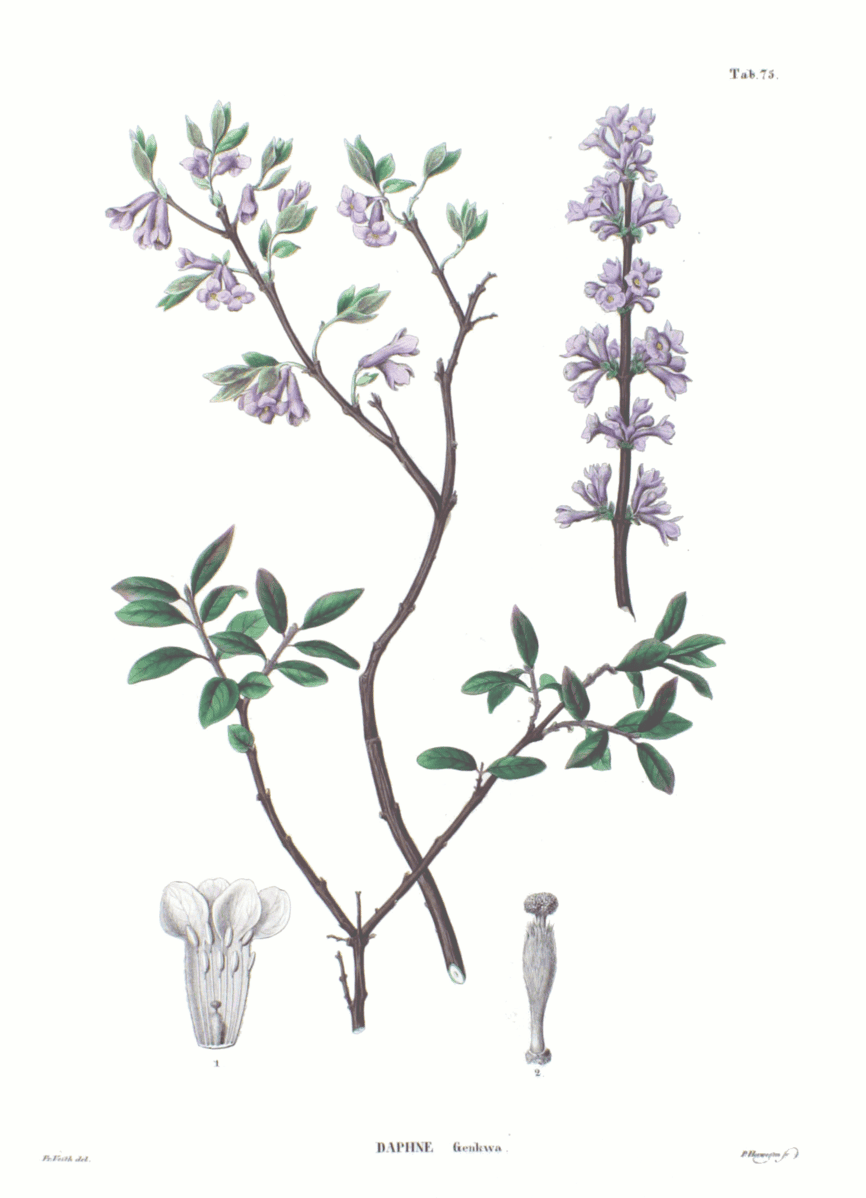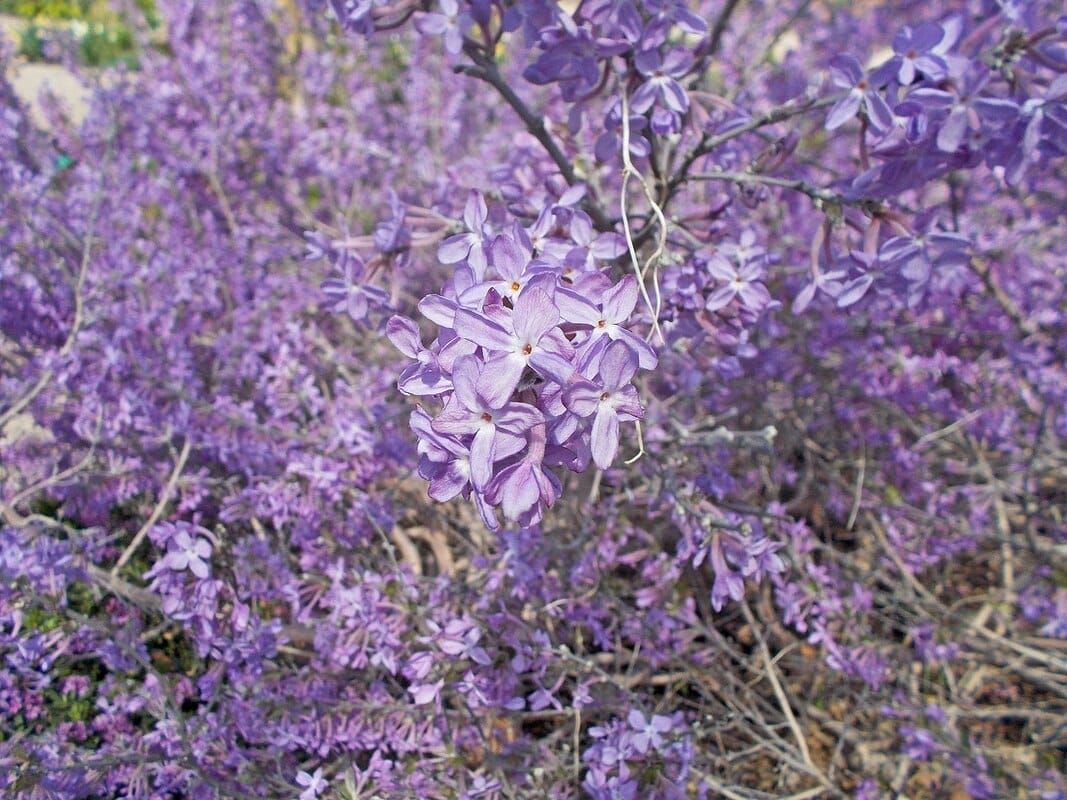Daphne genkwa, Yuan Hua 芫花Lilac Daphne flower budYuan Hua |

|

|
 (Flora Japonica,
(Flora Japonica, P. Franz von Siebold and J. G. Zuccarini, 1870)
 Daphne genkwa in flower
Daphne genkwa in flower(Photo by Andrey Zharkikh, cropped) (Wikimedia)
Botanical name:
Daphne genkwa
Parts used:
Flower; the Root is also used
Temperature & Taste:
Warm, dry. Bitter, Pungent. Toxic
Classification:
E. Cathartics
Uses:
1. Opens Obstructions, Purges Water:
-Water accumulation on the Chest and Abdomen
-Edema of the face or extremities
-Ascites, Hydrothorax
-‘It eliminates edema, five kinds of fluid-retention resting with the Five Viscera, in skin and with lumbago’ (Ming Yi Bie Lu)
2. Clears Cold Phlegm, Stops Cough:
-Cough, Chronic Bronchitis with profuse phlegm
3. Clears Phlegm, Resolves Swelling, Eases Pain:
-Toxic Sores, Eczema, Ulcers (topically)
-Mastitis
-Hepatitis (used in trials with benefit)
-adjunct for pain caused by obstruction
4. Resists Poison:
-Malaria
-traditionally for Parasites
-Rabies (root-bark)
5. Externally:
-Frostbite, Scabies, Tinea (decoction as a wash)
-Neurodermatitis
-Toothache
Dose:
1. Best to use the prepared flower internally.
2. It is not used continuously. Generally, a purgative containing Daphne flower is taken once every 3–7 days for several doses as needed, using tonic herbs in the interim.
Powder (of the vinegar-processed flower): 500–1000 mg
Decoction: 1500mg–3 grams
Comment:
1. It has been used to induce abortion.
2. The root is also used in TCM (though rarely). It is used for Edema, Abscess, Scrofula, etc.
Correctives:
1. Fresh Ginger
2. Chinese Date (Da Zao)
Substitutes:
1. Euphorbia Gan Sui and Euphorbia Da Ji are similar in effect. Euphorbia Gan Sui is strongest.
Preparation:
1. Vinegar stir-fried Daphne genkwa flower:
Stir frying with vinegar (300mls per 1 kg of flowers). This reduces toxicity, lessens side effects while enhancing its ability to clear Phlegm, Water and open obstructions..
An older method was to stew the flower in vinegar, then take it out and soak in water overnight, then dry in the sun. (Li Shi Zhen)
The Vinegar-prepared flower is best for internal use.
2. Aged Daphne genkwa flower:
‘After a few years storage, Yuan Hua becomes even better in its quality and function’. (Li Shi Zhen)
Main Combinations:
1. Ascites, Daphne flower with Euphorbia Gan Sui, Rhubarb (Da Huang), Lepidium Ting Li Zi
2. Worms with abdominal distention, Daphne flower with Orange Zhi ke
3. Chronic Cough and Bronchitis:
i. decoct Daphne flower and add Sugar
ii. decoct Daphne flower and inhale the fumes
iii. Daphne flower with Pinellia Ban Xia, Ginger (Gan Jiang), Licorice
4. Mastitis, Daphne flower is decocted with a egg, eat the eat and drink the decoction.
5. Toxic Sores, Carbuncles Daphne flower with Realgar (Xiong Huang) mixed with lard and applied.
6. Rabies, root-bark of Daphne genkwa is roasted and powdered. 3 grams are taken in water as a dose. This will cause passage of watery stool with with black masses of blood. Repeat every second day until stool are normal. (Barefoot Doctors Manual)
Major Formulas:
Shi Zao Tang
Cautions:
1. Toxic and draining. Use cautiously and only used in strong bodies. Primarily used internally to alleviate Ascites or Constipation.
2. Not used in the very young, the elderly, during pregnancy or breastfeeding.
3. Avoid in those with Gastric Ulcers or Gastrointestinal bleeding, Heart or Kidney disease.
4. Traditionally regarded as incompatible with Licorice.
Toxicity:
1. LD50 orally in mice is 17 g/kg (water extract), 14 g/kg (alcohol extract), 8 g/kg (vinegar prepared extract).
